Where is Burundi?
About Burundi
The Land
The People
Life and Death
Health, Energy and the Environment
Education and Work
Travel, Communication and the Media






Back to the Flags of Africa page

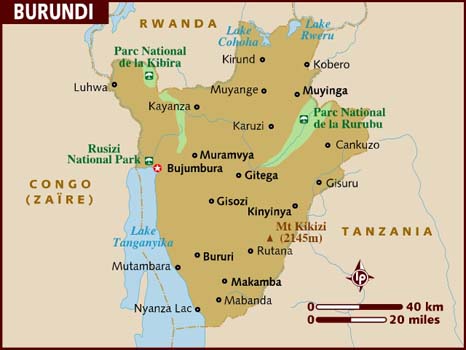


Burundi is a below-average size country in central Africa.
Burundi is a landlocked country with no coastal borders.
The land is mostly hilly and mountainous with a plateau in the east.
The geographical coordinates for the centre of Burundi, also known as lines of latitude and longitude, are:-
Latitude - 3 30S
Longitude - 30 00E
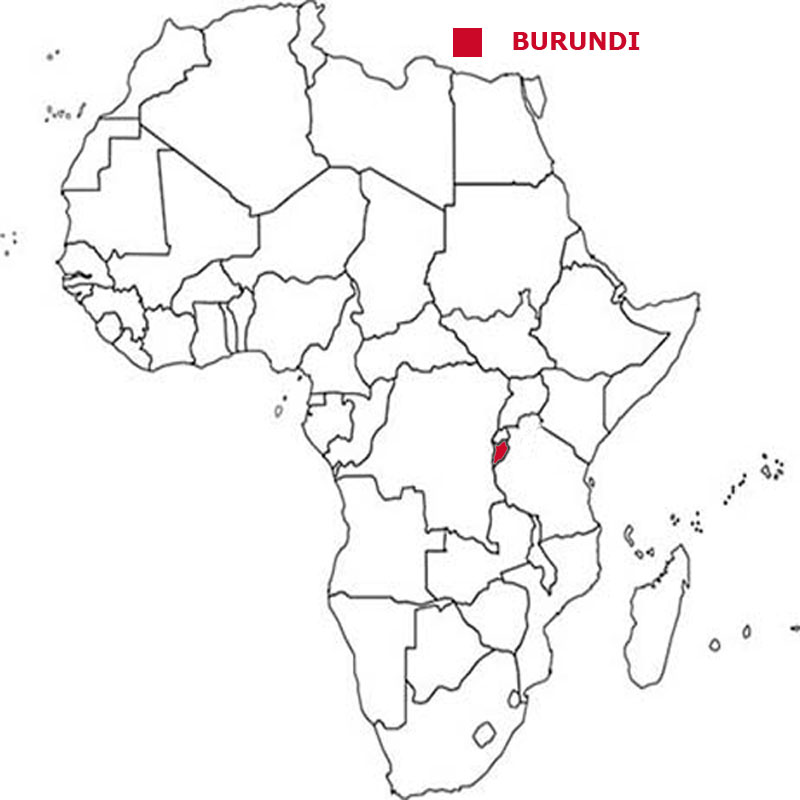

Check the weather in Bujumbura now.
This is the time in Bujumbura now
 The Burundian flag is divided into four panels by a white diagonal cross. The top and bottom panels are red while the two side panels are green. There is a white disc
in the centre with three red, six-pointed stars outlined in green arranged in a triangular design, one star above, two stars below. Green symbolizes hope and
optimism, white purity and peace, and red the blood shed in the struggle for independence. The three stars in the disc represent the three major ethnic groups; the
Hutu, Twa and Tutsi people as well as the three elements in the national motto, unity, work, progress
The Burundian flag is divided into four panels by a white diagonal cross. The top and bottom panels are red while the two side panels are green. There is a white disc
in the centre with three red, six-pointed stars outlined in green arranged in a triangular design, one star above, two stars below. Green symbolizes hope and
optimism, white purity and peace, and red the blood shed in the struggle for independence. The three stars in the disc represent the three major ethnic groups; the
Hutu, Twa and Tutsi people as well as the three elements in the national motto, unity, work, progress
Burundi is a presidential republic with a president as head of state and head of the government.
In elections everyone over the age of 18 can vote.
The currency in Burundi is the Burundian franc.
Kirundi and French are the official languages.
Hear the National Anthem
These are the anthem words
We have already written our own history of England but are asking schools in Burundi to provide us with a detailed history of
their own country. Check how here.
![]()
![]() Back to the top
Back to the top

The total land area of Burundi is 25,680 sq kms which is the 46th largest in Africa.
Burundi has no lakes, rivers and canals.
Burundi has boundaries with 3 countries
- Tanzania 589 kms
- Rwanda 315 kms
- Democratic Republic of Congo 236 kms
Burundi has no coastline.
The highest point in Burundi is Heha at 2,670 metres.
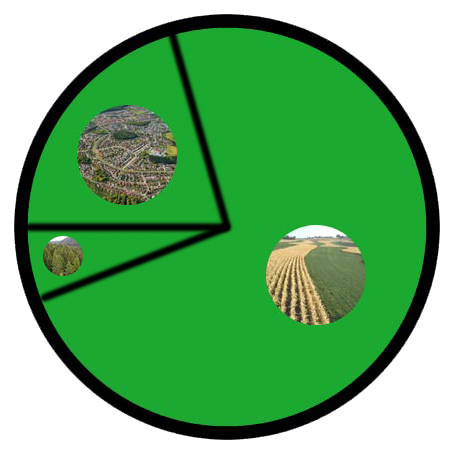

The total population of Burundi is 11.84 million people, making it the 30th largest country in Africa by population.
Of this number 5.94 million are females and 5.90 million are males.
A person from Burundi is called a Burundian.
To be a citizen of Burundi, your father must be a citizen of Burundi. It is not sufficient to be born in Burundi. You have to live in Burundi for
10 years before you can begin to apply for citizenship.
The largest five cities in Burundi, by population are:-
- Bujumbura 331,700 people
- Muyinga 71,076
- Gitega 41,000
- Ruyigi 38,458
- NgoziGalway 21,506
 Each little Owlbut is 1 person and
the big yellow rectangle is 1 sq km. After a while you can compare countries and see which ones are the most crowded. Remember it is only an average as
more people live closer together in towns and cities than in villages out in the country.
Each little Owlbut is 1 person and
the big yellow rectangle is 1 sq km. After a while you can compare countries and see which ones are the most crowded. Remember it is only an average as
more people live closer together in towns and cities than in villages out in the country.
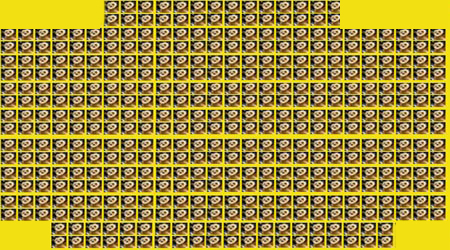
13.0% of the people live in cities or towns.

The birth rate in Burundi is 40.9 births per 1,000 of population
The death rate in Burundi is 8.6 deaths per 1,000 people.
Check this against the birth rate. If the death rate is higher than the birth rate then
the population will decrease unless immigrants arrive in the country.
There are 50.9 deaths of girls under 1 year per 1,000 of births and 63.7 deaths of boys.
The median age for females is 17.3 and for males is 16.8. The median age is that age which divides the population exactly in half so there are the same number
of people above the median age as below it.
The average age of a woman when she has her first child is 21.3.
The elderly dependency ratio is 4.7. This is the number of elderly people (ages 65+) per 100 people of working age (ages 15-64).
The potential support ratio is 21.1. This is the number of working-age people (ages 15-64) per one elderly person (ages 65+). As a population ages, the potential support ratio tends to fall, meaning there are fewer potential workers to support the elderly.
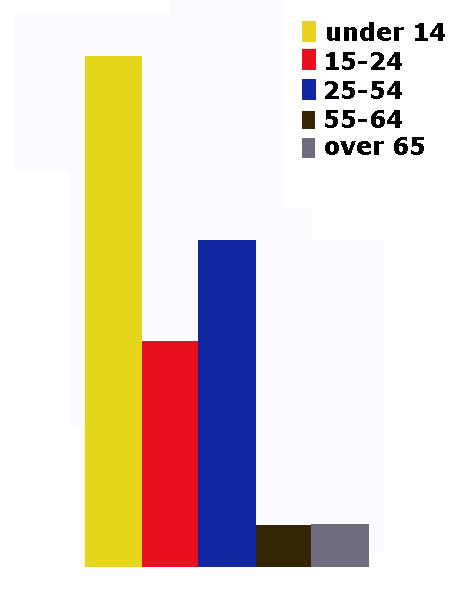
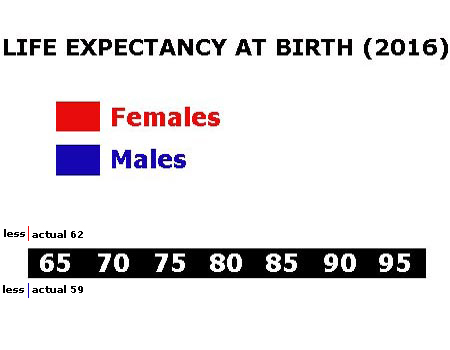

Burundi spends 7.5% of its total income on health care.
There are 0.05 doctors per 1,000 people.
There are 0.8 hospital beds per 1,000 people.
5.4% of the population are estimated as obese.
91.1% of the urban population and 73.8% of the rural population have drinking water that is either piped into their home or they have access to a public tap, a protected borehole, well, spring or
protected rainwater collection facility.
43.8% of the urban population and 48.6% of the rural population have access to a flushing toilet that is connected to a sewer, a pit latrine (that is a
permanent hole in the ground that is looked after) or a composting toilet.
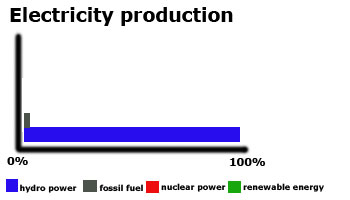
Burundi releases 0.3 million metric tons of carbon dioxide by burning fossil fuels in the process of producing and consuming energy. This puts it as the 50th highest in Africa.

Burundi spends 4.3% of its total income on education.
Children usually start school at age 7 in Burundi. Primary education is for six years until age 13 and secondary education can continue till 20. This may be followed
by further education at a university or college.
We are awaiting information about school terms in Burundi.
83.1% of females and 88.2% of males are able to read and write by the age of 15.
2.9% of all people aged between 16 and 24 are not in work. Among females 2.0% are unemployed while with males 4.0% can't find work.
The total number of people available for work in Burundi is 5.01 million.
 They work in the following sectors.
They work in the following sectors.
- Agriculture includes farming, fishing and forestry work
- Industry includes mining, manufacturing, construction and energy workers
- Services is everything else

There is 1 paved airports in Burundi, which is the 52nd highest number in Africa.
![]()
There are no kilometres of railways in Burundi.
![]()
There are 11,652 kilometres of roads in Burundi, which means Burundi is in 36th place for the most kilometres of roads in Africa.
![]()
There are 1 major national newspaper in Burundi.
There are 5.92 million mobile phone users.
Less than 1% of the people have a fixed landline.

574,235 people have access to the internet at home via any device (computer or mobile).


